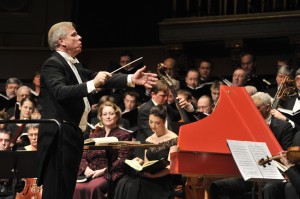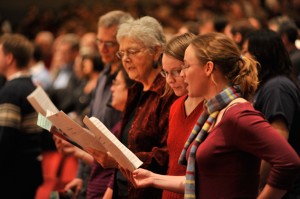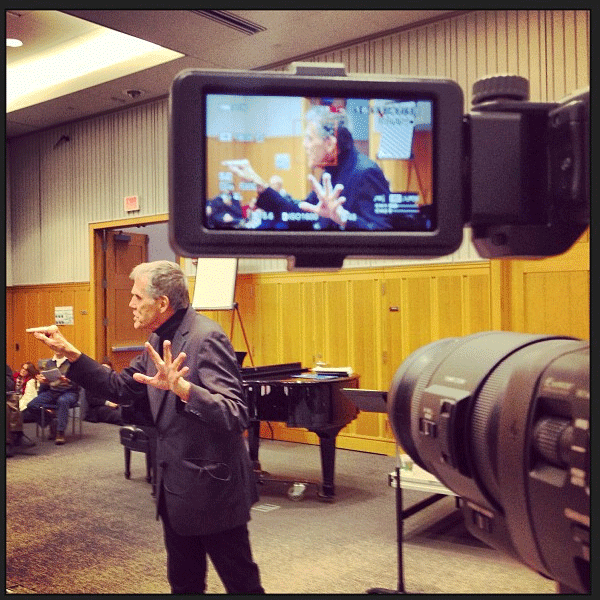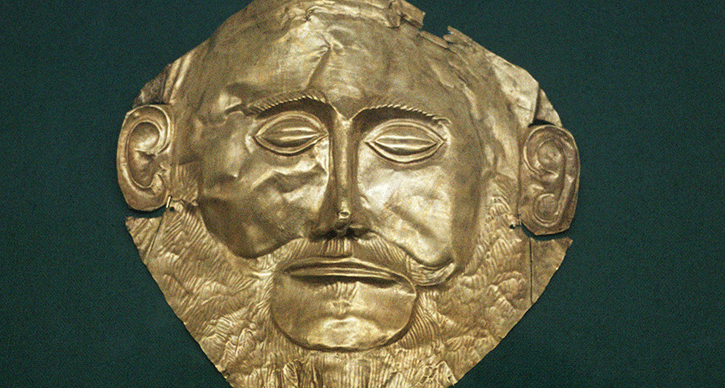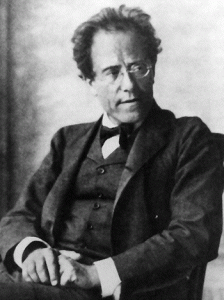Outgoing UMS Choral Union Music Director and Conductor Jerry Blackstone Inspires $100,000 Gift
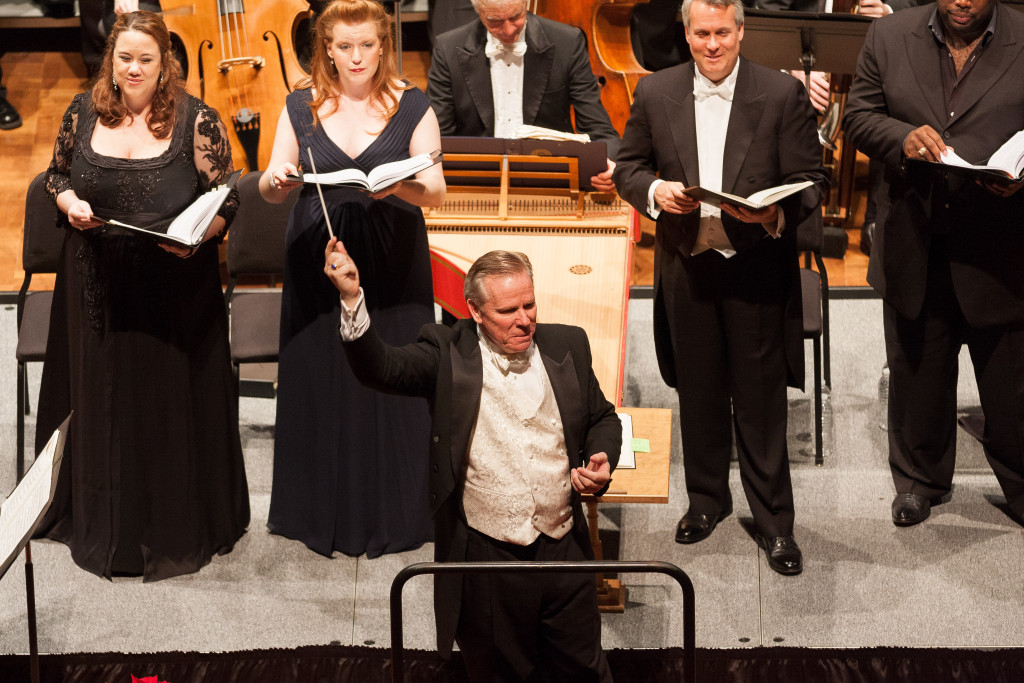 On Monday July 6, Jerry Blackstone, Director of Choirs and Chair of the Conducting Department at the University of Michigan, claimed the podium one last time as the UMS Choral Union Music Director and Conductor to lead singers in a reading of Francis Poulenc’s Gloria as part of the choir’s community music-making sessions entitled Summer Sings. A beloved Ann Arbor tradition, Summer Sings events bring together singers from all over the region to learn and sing together for one evening under the baton of some of our nation’s finest choral conductors. At the close of Poulenc’s monumental piece, participants basked in a moment of awe-inspired silence before erupting into appreciative applause for the timeless music, the memorable experience of singing together, and most importantly, for the work of Jerry Blackstone.
On Monday July 6, Jerry Blackstone, Director of Choirs and Chair of the Conducting Department at the University of Michigan, claimed the podium one last time as the UMS Choral Union Music Director and Conductor to lead singers in a reading of Francis Poulenc’s Gloria as part of the choir’s community music-making sessions entitled Summer Sings. A beloved Ann Arbor tradition, Summer Sings events bring together singers from all over the region to learn and sing together for one evening under the baton of some of our nation’s finest choral conductors. At the close of Poulenc’s monumental piece, participants basked in a moment of awe-inspired silence before erupting into appreciative applause for the timeless music, the memorable experience of singing together, and most importantly, for the work of Jerry Blackstone.
After 12 years of dedicated service as the UMS Choral Union Music Director and Conductor, Blackstone passed the baton to Scott Hanoian, whose appointment as the new leader of the UMS Choral Union began on July 1. In recognition of Blackstone’s service and incredible impact on the choir, the Jerry Blackstone UMS Choral Union Performance Fund was announced at Monday evening’s Summer Sings. Two anonymous donors, who wished to provide the UMS Choral Union membership with opportunities to perform an expanded repertoire of significant choral works, made gifts totaling $100,000 to establish the fund, which will be used to help pay for expenses related to the self-produced concert activities of the UMS Choral Union.
“The 175 volunteer musicians in the UMS Choral Union dedicate considerable time and talent for the benefit of our community. We are delighted to have a fund that will help enhance their experience through a robust season of choral repertoire,” said President Kenneth C. Fischer. “Jerry Blackstone has shown us that great music-making requires more than incredible technique and talent. It requires hard-work, thoughtful reflection, and a supportive community where musicians can be nurtured to see their fullest potential. The Jerry Blackstone UMS Choral Union Performance Fund recognizes the work of a beloved music director and paves the way for exciting projects to come.”
The fund is extended to all UMS Choral Union projects beyond UMS’s annual presentation of Handel’s Messiah that are not performed in partnership with a touring orchestra as part of UMS’s Choral Union Series or scheduled through the Detroit Symphony Orchestra as part of their concert series at Orchestra Hall.
Recent self-produced UMS Choral Union concerts include the 2015 presentation of Mendelssohn’s Elijah, the 2014 presentation of Brahms’s German Requiem, and the 2004 presentation of William Bolcom’s Songs of Innocence and of Experience, the Naxos recording that won three 2006 Grammy Awards (“Best Choral Performance,” “Best Contemporary Classical Composition,” and “Best Classical Album”).
In a recent interview, Karen Isble, Assistant Vice President for Development at the University of Michigan and longtime UMS Choral Union member, said of Blackstone: “Jerry has fostered the Choral Union community. His ability to be so musical and so warm and so inviting to everyone at every musical level really made the difference during his term as the music director.”
While the donors responsible for the Jerry Blackstone UMS Choral Union Performance Fund prefer to remain anonymous, they released the following statement about their gift: “Our hope is that this gift, and the naming of the fund in Jerry Blackstone’s honor, will encourage others who cherish choral music to add to the fund.”
While the end of an era is always bittersweet, the choir turns its eye to a promising future with incoming UMS Choral Union Music Director and Conductor Scott Hanoian, making his first public appearance in the new role at the next Summer Sings event on August 3 to lead a reading of Carl Orff’s Carmina Burana.
“Jerry Blackstone was a hugely influential teacher to me during my time as a music student at the University of Michigan and I’m honored to continue the tradition of great choral music-making in Ann Arbor, “ says Scott Hanoian. “The Jerry Blackstone UMS Choral Union Performance Fund will allow the choir to embark on the next chapter of our storied history. I can’t wait to see what will happen next.”
Donors interested in contributing to the Jerry Blackstone UMS Choral Union Performance Fund can do so online or connect with UMS Associate Director of Development Susie Bozell Craig at sbozell@umich.edu.
A Community of Singers, Right Here in Ann Arbor

Photo: UMS Choral Union on stage for Handel’s Messiah at Hill Auditorium. Photo by Mark Gjukich Photography.
Karen Isble is Assistant Vice President of Development at the University of Michigan, and she’s also been a member of the UMS Choral Union, Ann Arbor’s 137 year-old, Grammy Award-winning community choir, for nearly eight years.
We chatted with her about her most memorable experiences, including a performance in blizzard conditions, the community, and outgoing music director Jerry Blackstone.
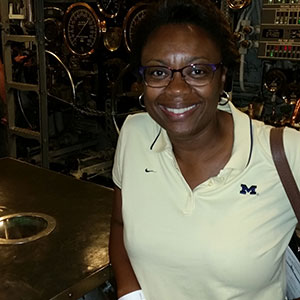
Karen Isble
UMS: What do you love about singing?
Karen Isble: I’ve been a singer all my life. I have two music degrees, one of them in voice performance from the University of Michigan. Earlier in my life, I had visions of becoming a professional performer. When that didn’t come to fruition, I wanted to make sure that I had an opportunity to use that part of myself. Singing became my avocation. I joined the UMS Choral Union in 2007 when I began to work for the University.
UMS: 2007, you’re coming up on eight years with the Choral Union, wow! What are some of the highlights of your experiences with the Choral Union?
KI: One of the highlights, and there have been many, was singing the Saint Matthew Passion several years ago in what was the last blizzard of that spring. I work here on campus, so I had an advantage over a number of folks who were coming in, some people come from as far as Ohio, and certainly from the rest of southeastern Michigan or East Lansing. Members of the Detroit Symphony were coming in from Detroit. We had a children’s choir coming in from Michigan State University.
This snow storm was horrible, and I think it was going to be a three hour concert. As the choir arrived, UMS president Ken Fischer came out on stage and said, “Let’s everybody get the choir on stage. We’re waiting for the orchestra to get here, we’re waiting for the kids to get here, go out and wave your hands so that the audience knows something’s happening.” So, I think, the choir, or those of us who had made it there, ended up going out and sitting on the risers for about an hour while we sort of waited for everyone else to arrive.
Amazingly, the house was packed. I thought there’d be tons of empty seats, but the audience was full to the rafters, all the way up to the second balcony. As each group of musicians showed up, these cheers would go up from the audience. And once the children’s choir arrived, there was an ovation. So then, about an hour late, we dove into this wonderful, wonderful, incredible piece of music, which I hadn’t sung in about twenty years up to that point. So I was really thrilled to have the opportunity to do it again. I had a small solo that Jerry Blackstone had granted me. It was a very transformative performance. It was just this badge of honor, we had made it through this blizzard and we had a wonderful evening.
UMS: A truly “Michigan” story!
KI: There were tales of people abandoning their cars. I remember that a member of the choir said, “I abandoned my car, I couldn’t drive any further. I just walked the rest of the way.” That sort of thing.
UMS: Has there been anything surprising in your experience with the Choral Union? Something that has challenged you or something that’s been a particularly good learning experience for you as a singer?
KI: Before the Choral Union, I’d mostly done solo singing, chamber music, small choir singing, and I wasn’t really sure I would enjoy singing with a group this size. Every year we’d start out with close to 200 folks of every skill level. What has surprised me over and over again is how beautiful and agile a choir of 150 to 200 people can be, and what incredible music we can make. It doesn’t happen all of the time, sometimes we’re just big and loud! But when we have an opportunity to be something a little different, I’m always pleasantly surprised at how well the group comes through.
UMS: It seems that there’s a real sense of community outside of the singing, too, within the group. Would you say that that’s true?
KI: I think that’s true. I think there are a lot of folks, certainly, who have been with the Choral Union for decades, and they have sort of formed that foundation. But I think one of the things that the group does well is have a huge spectrum of participants. We have students who join each year and are part of the equation, and that’s nice, and they’re a little more fluid. Many of the members are also one-time students who have come back a decade later, working in the Ann Arbor area now and looking for another creative outlet.
But definitely a sense of community. I think it grows on you the longer you are there. It takes a bit of time to find your place in a group that big. I certainly feel very at home with the Choral Union though I don’t know everybody, I don’t know that I ever could. You get to know the faces, and when you see them in unexpected places around town you kind of give that high-five or, “Hey, how’re you doing?”
UMS: What would you say to someone who is considering joining the Choral Union?
KI: For me, singing in the Choral Union is my respite from the day-to-day grind. It’s a wonderful escape. It’s hard, actually, sometimes to get myself pumped up for it on a Monday night after a full day’s work, but as soon as we start to sing, it’s almost immediate, and I always leave revitalized. And so I would say if people are thinking about it, weighing adding it to their schedule, that the Choral Union can re-energize you is a really important part of that.
UMS: The Summer Sings on July 6 is the final Choral Union moment for outgoing music director Jerry Blackstone. Would you like to say anything about your experiences with Jerry?
KI: I had the opportunity, as a University of Michigan grad student, to sing with Jerry. As I mentioned, he was the catalyst for my joining the Choral Union. Jerry has fostered the Choral Union community. His ability to be so musical and so warm and so inviting to everyone at every musical level really made the difference during his term as the music director.
Do you sing? New singer auditions for the UMS Choral Union will be held in August and September 2015.
Behind the Scenes with UMS Choral Union
Watch these behind the scenes moments with the UMS Choral Union and former conductor Jerry Blackstone as they prepared for a performance of Mendelssohn’s Elijah on February 14, 2015.
Interested in more? Explore the history of the UMS Choral Union, learn about new conductor Scott Hanoian, and get the details about upcoming audition information.
UMS Choral Union Sings Ken Fischer Happy Birthday!
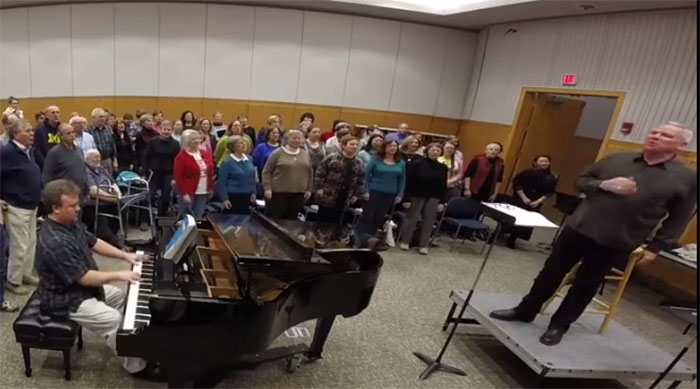
The Choral Union wished Ken Fischer, the UMS President, a Happy 70th Birthday last week! Watch the video here.
A Video History of Handel’s Messiah
In this interview, archivist Richard LeSueur shares the history of this Ann Arbor holiday tradition:
UMS first presented Handel’s Messiah in December of 1879, and we’re kicking off the holiday season with this year’s performances on December 3 and 4, 2016.
Last updated 4/29/2016.
Happy 200th Anniversary, Star-Spangled Banner!
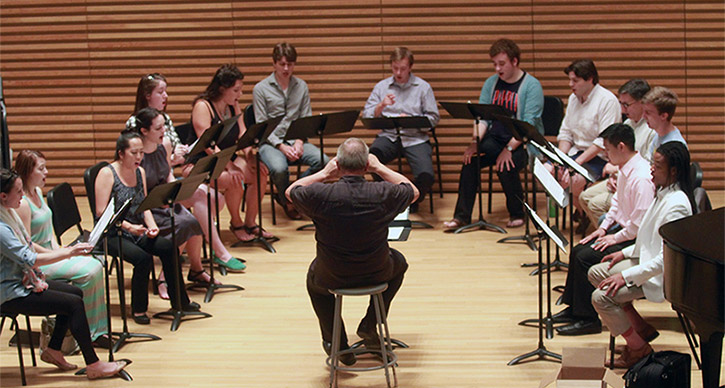
Photo: Conductor Jerry Blackstone and University of Michigan students rehearse “The Star-Spangled Banner” in advance of their concert at Hatcher Library.
September 14, 2014 marks the 200th anniversary of the U.S. national anthem “The Star-Spangled Banner.” It’s amazing to me that the date is here! My own fascination with the anthem grew out of my teaching of an almost annual course on American music. The first class in this course always focused on the question of what an explicitly “American” music might be and why (if at all) national identity might be important. In hopes of forging a connection with my students and getting a great discussion going, I began using the U.S. Anthem as a vehicle to consider the question of national identity in music. All of my students have some relationship to the song, whether they grew up singing it in school or even if they are an international student visiting the University to study who is struck by the unusual prominence of the song in American life.
I often play Jimi Hendrix’s Woodstock Anthem as part of this session, but wanted to showcase a recording of the original song Key used as a melodic vehicle for his lyric—“The Anacreontic Song”—as well as of the first version of “The Star-Spangled Banner” in full 1814 style. It surprised me that I couldn’t find either. So, since this is the University of Michigan and we had ready access to a great recording venue and incredibly talented student musicians, we made our own! My colleague Jerry Blackstone, who conducts the UMS Choral Union among his duties directing choral music at the University as a whole, signed on as a collaborator and took the project to a new artistic level.
Our recordings are now published as part of a two-CD set titled Poets & Patriots: A Tuneful History of “The Star-Spangled Banner.” It has been featured by the Smithsonian, The New York Times, C-Span, Encyclopedia Britannica and others and its related videos have been viewed over 55,000 times on Youtube. Just today the Library of Congress released its video of the July 3, 2014 recital by Thomas Hampson that features our music. It was a lifetime thrill to be joined by University of Michigan alumni singers and to be able to present my research with Hampson at the Library’s Coolidge auditorium. Pretty good for a class project!
Jump to 6:12 for Mark Clague and Thomas Hampson:
As I continued to do research, I found the story of America’s Anthem to be ever more fascinating. Its bicentennial offered the further opportunity to share my love of the song and its story more widely. For me, the story of “The Star-Spangled Banner” is the story of American democracy in action. It’s also about the vitality of music in our lives. The anthem is more than a song; it’s a sounding board that helps us figure out who we are and who we want to be.
University of Michigan Events & Live stream
You can learn more about the song through a whole series of campus events at the University of Michigan this fall, beginning this weekend with #Anthem200 celebrations as part of the Michigan Marching Band halftime show and a 1-hour grand opening recital at the Hatcher Graduate Library on Sunday, September 14 at 4 pm. (It’s just before you head to Hill Auditorium to hear Itzhak Perlman at 6 pm). Attend the events in person, or watch online via live stream.
I truly hope you’ll be able to visit the U-M Library exhibit which features items from U-M’s incredible collections, especially the William L. Clements Library which preserves (and thus we will display) one of only a dozen surviving copies of that original 1814 sheet music edition that started our whole project.
Other Star-Spangled Banner Resources
Complete listing of events at the University of Michigan
U-M American Music Institute
StarSpangledMusic.Org
Behind the Scenes with countertenor David Trudgen
This post is a part of a series of playlists curated by artists, UMS Staff, and community. Check out more music here.
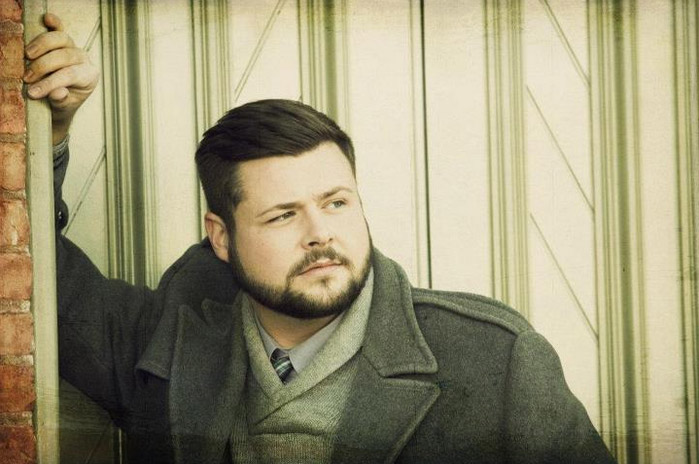
Photo: David Trudgen. Courtesy of the artist.
Countertenor David Trudgen performs in Handel’s Messiah on December 7 and 8, 2013. We had the chance to chat with David about his time in Ann Arbor and about what he’s been listening to lately. Check out his selections in the playlist below.
UMS: We know that you’re a University of Michigan alum. Can you talk a little about your time in Ann Arbor, and what you’re looking forward to in coming back?
David Trudgen: Looking back at my 2 years at Michigan brings up so many fantastic memories, but also reminds me of the opportunities I came to through U-M, like the chances to sing at Carnegie Hall in NYC and at the Kennedy Center in DC. And of course, I loved attending football games at the Big House.
For having as much fun as I had, I also worked very hard. I spent most of my free time at the School of Music, Theatre & Dance, where I was constantly learning new music, and trying to absorb all I could, because I knew this school could give me the tools that I needed to succeed as a musician. I wouldn’t have gotten to where I am without the advice of George Shirley, my voice professor, Martin Katz, my vocal coach, and all of the professors at the U-M School of Music.
I am so excited that UMS has asked me come back to perform as part of this year’s Handel’s Messiah. I remember attending Messiah at Hill Auditorium while I was in school and dreaming about singing this piece on the stage of this amazing building. Who knew that dream would come true? I also wanted to say another special thanks to Dr. Jerry Blackstone and UMS for the invitation. I feel honored to come back to sing at my Alma mater!
David’s Playlist:
Four Sea Interludes from Peter Grimes by Benjamin Britten
Symphony No. 3 by Henryk Górecki with Dawn Upshaw, Soprano
Chasing Pavements by Adele
Make You Feel My Love by Adele
“As with rosy steps the morn” from Theodora by Handel with Lorraine Hunt Lieberson
Piano Concerto No. 1 in B-flat minor, Op. 23 by Pyotr Ilyich Tchaikovsky
Burn by Ellie Goulding
Love Game by Lady GaGa
You and I Both by Jason Mraz
“He has come…. Do not utter a word Anatol” from Vanessa by Barber with Renee Fleming
Let me touch you for a while by Alison Krauss
Brasileiras No. 5 Aria Cantilena by Heitor Villa-Lobos with Renee Fleming
Bohemian Rhapsody by Queen
Sleeping Sickness featuring Gordon Downie by City and Colour
Sex on Fire by Kings of Leon
Hey Mama by the Black Eyed Peas
What Now by Rihanna
Selected tracks on our Spotify playlist:
What did you think about this playlist? Share your thoughts or song suggestions in the comments below.
‘Tis the Season: Your Messiah Memories
An annual tradition since 1879, UMS’s presentation of Handel’s Messiah has become a “signature” Ann Arbor experience. We’re so grateful for the participation of the community in this event year-after-year, and we hope you’ll share with us some of your favorite Messiah memories: how many years you’ve attended, why you look forward to Messiah every year, what makes this event special to you.
Share your memories with us in the comments below, or on Facebook, Twitter, or Instagram with hashtag #umslobby. Photos welcome!
Over the year’s we’ve also collected video memories. Here are a few audience reactions to last year’s performances.
These two are getting a bit of off-camera direction…
Graduated U-M in 1978, and attended ever since…
Snow storm strikes in the middle of Messiah…
Whole family in the video booth…
And here are some of our favorites from throughout our history.
Jerry Blackstone, director of UMS Chormal Union and long-time Messiah conductor, on forgetting his jacket on the day of a Messiah performance.
Father Timothy Dombrowski, choral union member for over forty years, remembers “The Bat out of Hill.”
Megan Sajewski, U-M alumni and resident of Martha Cook dormitory, talks about co-chairing the annual Martha Cook Messiah Dinner.
Last updated 4/29/2016.
Ralph Williams talks about Oresteia of Aeschylus
Ralph Williams, Professor Emeritus of English at the University of Michigan, gave a lecture on the Oresteia of Aeschylus prior to a UMS Choral Union rehearsal. The UMS Choral Union performs as part of Darius Milhaud’s Oresteia of Aeschylus on April 4.
Lecture:
Want to learn more about the project? Read interviews with composer William Bolcom, who studied with Darius Milhaud, Kenneth Kiesler, conductor, Jerry Blackstone, chorus master, and Joseph Gramley, co-director of percussion.
Oresteia of Aeschelys: Interviews
When Hill Auditorium was first built, UMS was the organization that oversaw the School of Music, a situation that held true until the early 1940s, when UMS transferred oversight of the School of Music to the University of Michigan.
To commemorate 100 years of collaboration, we celebrate with a massive orchestral and choral work, Darius Milhaud’s Oresteia of Aeschylus, set for vocal soloists, chorus, orchestra, and a battery of percussion instruments, which will be performed in Hill Auditorium on April 4.
We sat down to interview composer William Bolcom, who studied with Darius Milhaud, Kenneth Kiesler, conductor, Jerry Blackstone, chorus master, and Joseph Gramley, co-director of percussion.
Interview 1: William Bolcom, composer and student of Darius Milhaud.
UMS: How did you come to study with Darius Milhaud and how did he influence you as a composer? Can you talk about Milhaud’s style of composition and his impact on composition today?

Photo: William Bolcom
William Bolcom: In 1957 I was a given a scholarship to study with Milhaud at Aspen, then in its first years of the festival. I’d liked his music at a time when he was generally thought of as inferior to Hindemith, then considered by many the Bach of our time. In retrospect I remember liking some early Hindemith pieces and studying his The Craft of Musical Composition, but having played the piano part for several of his solo-instrument sonatas I soon detected something formulaic in his work; that disenchanted me. In Milhaud’s music, even the slightest of his works has freshness and a huge potential emotional range from comic to tragic, an interest in popular music of various provenances, all things that I was already pointed toward, sometimes willy-nilly, and definitely not in sync with American attitudes toward composing at the time.
We seemingly hit it off quickly and I became close with the family, and still am. (One day in 1960 the Mlihauds would invite me to dinner to meet their son Daniel at their Pigalle apartment; a brilliant painter and sculptor, he has become one of my very closest friends and will be here for l’Orestie. We always stay with them when in Paris.) Milhaud obtained a scholarship to Mills College which I took in 1958, pursuing a masters’. The next year I followed him to the Paris Conservatoire on a French government grant and stayed a second year, when I pursued Messiaen’s course in “analyse musicale” (I left in February 1961, having been called by the draft – totally another story.)
In 1958 and for about two decades after, general opinion of Milhaud and his work was not what it has now proved to be over time – it was easy then to dismiss someone who was not a post-Webern serialist like the most famous European composers like Boulez, Stockhausen, and Berio (the latter less doctrinaire than the other two, and a friend of Milhaud’s and eventually mine). Milhaud could be very serious but had a strong streak of humor in his work and person, and was delightful company.

Photo: Darius Milhaud
So Milhaud’s influence on my music is more of a matter of spirit than technique. He wanted everyone to go his/her own way musically (one of his deepest disappointments is that none of his Mills female students had much of a career, except Anne Kish who died very young) but required a student coming to him to have already a strong technique, which I thankfully had when I came to him. His own work shows remarkable facility and fleetness. His espousal of polytonality was the rage in the early 1920s – have I used it to his extent? no – but as with Schoenberg and twelve-tone, he rarely talked about it, finding other aspects of composition to be more important. His openness was a great example for me in composition and teaching. In many ways we were of one mind, including his eschewing of solemnity but espousal of seriousness, even in humor. This would result in many critics and academic composers not taking him (or me) seriously for a long while.
His impact on composition today is probably more general then technical. Polytonality, his trademark, is considered one technique among many, and unlike the serialists there was never pressure on his part toward any sort of ideological conformism. Perhaps the relative openness and lack of uniformity today can be somewhat ascribed to his example.
UMS: Why do you think UMS and the School of Music chose to perform and record Milhaud’s Oresteia of Aeschylus?
WB: I had lobbied quite a bit for l’Orestie to be performed here in the same spirit in which U-M put on my Songs of Innocence and of Experience… (actually twice, first here in 1984 as the second performance – the premiere was in Stuttgart that year – and of course in 2004 [at Hill Auditorium]). I realized the size of the project would be about the same as my Songs…, which may have been inspired by l’Orestie’s example, and I was delighted when it was decided to use it [….] to celebrate Hill Auditorium’s 100th anniversary. It will be performed 9 years to the day of the April 2004 performance of my Songs.
UMS: What were the challenges in performing and recording your large scale Grammy award-winning work Songs of Innocence and of Experience? We know that the process will be similar for the recording of Oresteia.
WB: I have come to learn from Maestro Kiesler that in the case of l’Orestie a great deal of unearthing had to be done in the Milhaud; the parts were in wretched shape with whole sections missing for example, and there are questions of interpretation not easily resolved by studying the score. The last performance I know of the work was in Berlin in the 1980s.
In my case the Songs had been heavily roaded, and recently, with performances at the Stuttgart Opera, U-M, Grant Park, St. Louis, and the BBC and Pacific Symphonies; Leonard Slatkin had done two of them, which is why I selected him for the performance and recording here in 2004 (so that I feel for Maestro Kiesler, considering his recovery from an injury and so many things to resolve in the Milhaud score itself). UMS had hired a stellar cast of singers, some from previous performances, for the Ann Arbor event.
Many people think that the Naxos recording is of the April 4, 2004, performance; far from it, as equalization and other production problems, such as some people using mics and others not, that necessitated sessions for the following two days after the performance. Our David Lau was the head engineer but the producer was the legendary Tim Handley, who had a Tonmeister degree and the attitude to go with it; it was worth it as he was excellent (and would win one of the 4 Grammys the recording garnered). The whole thing was elegantly planned out, so that no one had to hang around waiting – the engineers would deal with all the choral ensembles in one session for example. The result was that the enthusiasm and freshness in the performance was preserved in the recording; this even fooled Maestro Slatkin, who was surprised to hear no applause at the end of the first edit.
UMS: Do you think the University Orchestra and Choirs will face similar challenges in performing and recording Milhaud’s Oresteia?
WB: I would guess that, for reasons stated above, l’Orestie will pose greater problems for performance and recording than my Songs did, first of all because it hasn’t benefited from carryover singers (as we did) or much recent performance. Too, the work is in French, and a very elevated French requiring the grand style of utterance Claudel required in his plays (recalling the era of Corneille and Racine); I’m hoping for the ultimate in diction work from soloists and chorus. I have great hopes that it will go just fine, but I recognize the enormity of the challenge.
Interview 2: Jerry Blackstone, chorus master and conductor of UMS Choral Union.
UMS: What is your role in this collaboration between UMS & UM School of Music, Theatre & Dance in the performance and recording of Darius Milhaud’s Oresteia of Aeschylus?

Photo: Jerry Blackstone
Jerry Blackstone: I am the chorus master for this production of the Oresteia. There are approximately 310 singers currently in preparation for this monumental event: 3 from the School of Music, Theatre, & Dance (Chamber Choir, University Choir, Orpheus Singers) plus the UMS Choral Union. I am being assisted by Prof. Eugene Rogers, conductor of the University Choir, George Case, the UMS Choral Union assistant conductor, and eight graduate conducting students who are assisting with the Orpheus Singers and with sectional rehearsals of the Chamber Choir and University Choir.
My job is to ensure that the singers know the notes, rhythms, French text (and there is a great deal of it!), and textual and dramatic content. We want them to be completely comfortable when Maestro Kiesler takes over the musical preparation in a few weeks.
UMS: How was this piece selected for this commemorative performance?
JB: William Bolcom has been encouraging several of us at UMS and the School of Music, Theatre & Dance to consider this work. Mr. Bolcom was a student of Milhaud’s and thinks very highly of the piece. The possibility to present it in its entirety, in a great hall, and then to record it for a major recording label, is remarkable. It truly is a monumental piece and we will always remember this moment in the life of Hill Auditorium.
UMS: What are your hopes for this performance and the recording of the work?
JB: I’m committed to making this music come alive, to communicate the drama and excitement that is so inherent in these important texts to the audience. The recording process will may be tedious and somewhat tension filled, as most recording sessions are, but we’re all committed to a musical moment and recorded product that will tell these stories with all of the power and spark they deserve.
Interview 3: Kenneth Kiesler, conductor.
UMS: What is your role in this collaboration between UMS and the School of Music in the performance and recording of Milhaud’s Oresteian Trilogy?

Photo: Kenneth Kiesler
Kenneth Kiesler In a piece like this, the conductor’s role is quite complex and multifaceted. First, I have to learn the music and figure out what it’s all about, and prepare to give every word, every phrase, every sentence its meaning, its subtext.
The other thing is, you know, with all opera (and by the way, [Darius] Milhaud didn’t want to call it an opera and [Paul] Claudel didn’t want to call it an opera. They didn’t like the kind of stand-and-sing detachment of opera singers in those days, they wanted it to be a real theater piece, really invested with the motivations of the characters) is that we have to go back to the words and forget that there is a piece of music temporarily. That for me has been a very labor intensive process.
UMS: In your view, what was the process for selecting the piece for this performance?
KK: The music is incredibly well constructed and absolutely beautiful and powerful. There is absolutely no question that Stravinsky, and particularly the Rite of Spring, had a huge impact on Milhaud. He started Agamemnon in 1913, and most of the work was completed in 1913, which is why we are choosing 2013 and the 100th anniversary of Hill Auditorium for our performance date.
This has been in the works since 2004, when William Bolcom first sent Les Eumenides to me to take a look at it. The piece immediately was so huge, I mean the scores stood about two-and-a-half or three feet high, and they were standing on the floor in my studio for a couple of years before I really took a close look at it. In 2008, I started to do more research on the piece, and we’ve been developing the project since around then.
UMS: What are the challenges in leading such a large scale ensemble?
KK: To me, no matter how large the music is, the ideal that we strive for is chamber music. That goal becomes a challenge (though it’s already a challenge for us with any large orchestra) when you add chorus to this kind of music, this many players, soloists, and principal singers increases the intensity of the work. But, I have a lot of experience doing choral orchestra works because it’s a repertoire I’ve always loved. I’ve done some recordings with chorus alone that are on Naxos, and I’ve been the music director of choirs earlier in my career.
Also, in this piece, unfortunately, Milhaud wrote almost no instructions for the chorus and soloists. There’s hardly ever an articulation mark and they are missing dynamics 90% of the time. So everything has to be done from scratch, beginning with what the words mean, what the scene is about, and what the orchestra’s playing.
Additionally, choirs don’t sing in French every day. There aren’t that many pieces in French in the concert oratorio repertoire. They are usually in Latin, or English, or German. That’s an interesting challenge for the singers as well.
UMS: What goals do you hope to achieve by performing and recording this historic and rare work?
KK: Well my highest priority is that the audience and future listeners to the recording fully get that they really have the drama, the story, the contemporary quality that it is us as well, we’re continuing. In terms of the themes of the piece, there’s a lot of bloodshed in this story. It needs to be not just violence that’s talked about but that we understand the causes of it and so we can apply the lessons to our own lives. And also, I hope that Milhaud’s genius is appreciated and that this piece becomes a part of the repertoire.
But, I want to add that what I’ve found fascinating is that we’re still dealing with the themes of this piece today. We’re still dealing, for example, with the relationship with the governed and the governors, with jealousy and revenge and the relationship of men and women, with lessons about excess. Those and many other issues are the same concerns that we wrestle with now, so I think audiences will connect deeply to the piece for this reason.
Interview 4: Joseph Gramley, co director of the percussion ensemble from the University of Michigan School of Music, Theatre & Dance.
UMS: What’s your role in this collaboration between UMS and the School of Music in the performance and recording of Darius Milhaud’s Oresteia of Aeschylus?

Photo: Joseph Gramley
Joseph Gramley: My role is as co-director of the percussion ensemble from the University of Michigan School of Music, Theatre & Dance. This piece is unique in that it utilizes 17 percussionists within the orchestra. This is extremely rare and is actually the most percussionists I’ve ever seen in my experience performing with an orchestra or in an opera. I once played on stage at the Metropolitan opera for Tan Dun’s First Emperor, and we got up to 16 percussionists. So, I now have a new personal best! As co-director of the percussion ensemble, I am charged with coaching and preparing — with my colleague Jonathan Ovalle — those movements of the opera which utilize the larger percussion forces.
UMS: What’s special about the role of percussion in this piece?
JG: It’s interesting because this year in my percussion literature seminar class at the University we are actually also focusing on Milhaud. Milhaud is responsible for having written the very first percussion Concerto — it’s from 1929. He also composed a very interesting and important chamber work entitled La Creation du Monde. Like the operas upcoming, the Concerto and La Creation du Monde both utilize standard Western orchestral percussion instruments and elements of jazz drumset. His orchestration is very interesting insofar as he augments the uses of what would have been considered exotic instruments at that time but are now considered standard.
UMS: What’s been challenging as the rehearsal process has gotten going?
JG: To be honest the sheer logistics of this project have been daunting. The University has been very supportive of the percussion ensemble over the last 50 years, and Michigan has one of the most well-known and important percussion ensembles in the history of the idiom. Besides being a performing entity, this group is also a course at the University — therefore we have a regular class time where all seventeen of us can work together and prepare.
UMS: What are your hopes for this performance?
JG: Of course we want great balance and great sounds within the ensemble — in addition to that, I hope that we communicate the content in a way that the UMS audience receives it with great interest.
UMS: Anything else you’d like to add?
JG: I would personally like to thank my colleague Jonathan Ovalle from the University of Michigan percussion program. I would also like to thank Emily Avers and Paul Feeny from the School of Music, Theatre & Dance ensembles office. They are instrumental in the success of this project. It is indeed a team effort!
This is a once-in-a-lifetime opportunity for the UMS audience to experience an amazing work. The vocal writing is intense and unique — and the spoken soloist Sophie Delphis is not to be missed!
UMS Choral Union music director Jerry Blackstone with Beethoven
The UMS Choral Union took the stage this weekend in Detroit for a performance of Beethoven’s 9th with the Detroit Symphony Orchestra! Here’s UMS Choral Union music director Jerry Blackstone with Ludwig himself backstage.
[VIDEO] Messiah Memories: Jerry Blackstone, Conductor
UMS first presented Handel’s Messiah in December of 1879. We’re kicking off a webisode series of Messiah Memories from everyone involved over the years. In this episode, Jerry Blackstone, long-time Messiah conductor, forgets his jacket on the day of the performance.
Comment below with your own Messiah Memories!
Michigan Messiah: Jerry Blackstone, conductor
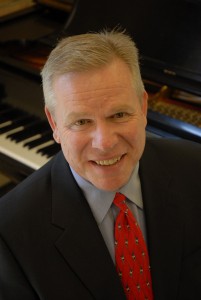 What a treat for me to welcome these four wonderful singers to the Hill Auditorium stage and our 2010 performances of Messiah. I’ve known three of them since their high school days and one of them since his undergraduate years at the University of Michigan. They are all mature artists now and I am so looking forward to working with them again and introducing them to our wonderful UMS Messiah audience.
What a treat for me to welcome these four wonderful singers to the Hill Auditorium stage and our 2010 performances of Messiah. I’ve known three of them since their high school days and one of them since his undergraduate years at the University of Michigan. They are all mature artists now and I am so looking forward to working with them again and introducing them to our wonderful UMS Messiah audience.
Caitlin Lynch
I met Caitlin when she was a high school singer in the University of Michigan All-State High School Choir at Interlochen. I conducted the choir for 17 summers, and I remember thinking Caitlin had potential from the moment I heard her sing. As an undergraduate student in vocal performance in the School of Music, Theatre & Dance at the University of Michigan, Caitlin sang in the Chamber Choir, which I conduct, and I watched her grow in poise and confidence and her voice grow in size and timbre. When I heard her sing recently and watched her YouTube clips, I knew we had to have her sing Messiah with us.
Meredith Arwady
Meredith grew up in Michigan and I met her when she sang in the University of Michigan All-State High School Choir at Interlochen. Her outgoing, vibrant personality and incredible vocal gifts were immediately apparent and I have kept my eyes on her career. I recently saw the video production of John Adams’ terrific opera, Dr. Atomic, recorded live at the Metropolitan Opera, and there was Meredith singing one of the leads! I knew immediately that we should try to engage her for a Messiah weekend, and I am very pleased it worked out.
Nicholas Phan
Ann Arbor native Nicholas Phan sang with me as a high school student in the Michigan Youth Chamber Singers, a choral ensemble I conducted for many years here in Ann Arbor. Nicholas’ voice was already very beautiful. During his student days in the School of Music, Theatre & Dance at the University of Michigan, Nick sang in the Chamber Choir, which I conduct, and had many solos with the ensemble and in SMTD productions. His career has blossomed and I am so pleased that he will be our tenor soloist for this year’s Messiah. I will always remember a Messiah the Chamber Choir sang with the Detroit Symphony Orchestra several years back, when Nick was a member of the tenor section in the ensemble. Could they SING! Now, HE’S out front, and it is a thrill to welcome him home.
Michigan Messiah: Nicholas Phan, tenor
It’s Messiah week at UMS–and extra special this year is our cast of soloists–all have Michigan connections! Some are Michigan natives, some are alumni from U-M’s School of Music, Theatre & Dance, and some are both!
This week, we will feature a post from each Messiah soloist, where they will reflect on what it means to return to Michigan and sing in our annual tradition of Handel’s Messiah!
The very first time I ever heard Handel’s Messiah, I remember sitting in the first balcony of Hill Auditorium, carefully reading 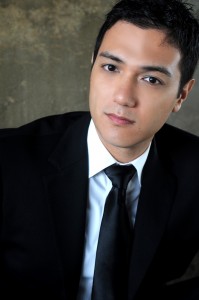 the program notes before the performance, trying to understand what exactly this Messiah-thing was. I was so young I don’t even remember precisely what year it was, but it was long before I ever considered becoming a singer. The reason I remember going was to see my violin teacher play in the Symphony. I had lots of questions: Did it tell a story? Why do we all stand up to sing along with that “Hallelujah” moment? What is an “Oratorio,” anyway? My inquisitive mind absorbed as much as it could before the first notes of the Overture. From that moment on, I was transfixed.
the program notes before the performance, trying to understand what exactly this Messiah-thing was. I was so young I don’t even remember precisely what year it was, but it was long before I ever considered becoming a singer. The reason I remember going was to see my violin teacher play in the Symphony. I had lots of questions: Did it tell a story? Why do we all stand up to sing along with that “Hallelujah” moment? What is an “Oratorio,” anyway? My inquisitive mind absorbed as much as it could before the first notes of the Overture. From that moment on, I was transfixed.
The first balcony of Hill was my favorite place to see concerts while I was growing up in Ann Arbor. It felt like the perfect distance from the stage—I wasn’t too far away to feel disconnected (not that distance matters in Hill—the sound actually gets better the higher up you sit), and I wasn’t too close, so I could see all of the action without missing a thing. It was from that first balcony that I caught a glimpse of how powerfully expressive music-making could be, watching Yo-Yo Ma play the Dvořák cello concerto with the Orchestra of St. Luke’s, getting my first taste of live great singing when Cecilia Bartoli offered a recital, and having my heart broken by Les Arts Florissants’ semi-staged performance of Acis and Galatea.
I cultivated my passion for classical music as an audience member in Hill, and it was on the stage that I cut my teeth as a young performing musician. It was in Hill, sitting in the back of the viola section of the Michigan Youth Symphony where I discovered what it was like to play in a large symphony orchestra. A year later, on a whim, as a sophomore in high school, I went to sing a last minute audition for Jerry Blackstone to try and get into the Michigan Youth Chamber Singers. Not having anything else to sing for him, I sang the national anthem. After I had finished, he said “sounds great!” and told me to go pick up some music for our first rehearsal that afternoon. A few months later, he would assign me my very own first, tiny oratorio solo to sing in Hill in Mozart’s Regina Coeli, and my journey as a singer had begun. I would spend the next seven years performing intermittently and even recording in Hill as a choral singer and soloist, honing my craft and gaining valuable experience that would set the foundation of what would turn out to be a life in music. To come back to Hill for such an important UMS tradition, standing on stage as a colleague with the people who started me on this life journey, marks not only a dream come true, but the ultimate homecoming.
—Nicholas Phan, tenor soloist, Ann Arbor native, and U-M School of Music, Theatre & Dance alumnus
Michigan Messiah: Caitlin Lynch, soprano
It’s Messiah week at UMS–and extra special this year is our cast of soloists–all have Michigan connections! Some are Michigan natives, some are alumni from U-M’s School of Music, Theatre & Dance, and some are both!
This week, we will feature a post from each Messiah soloist, where they will reflect on what it means to return to Michigan and sing in our annual tradition of Handel’s Messiah!
Dr. Blackstone (whom my dad has always referred to as Dr. Whiterock) is the reason that I fell in love with music. I attended the 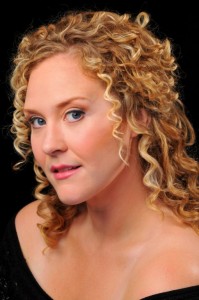 Interlochen All-State High School Choir Camp for four summers and he was our conductor. He was my first real conductor and he terrified me! He was so smart and so serious about music-making and choral singing. His validation was my ultimate goal—I just wanted to be worthy of singing in his choir. When I was given a tiny solo in “Freedom Come” my first summer there, I thought I had died and gone to heaven. Those summers at Interlochen were magical: I spent the first two with my best friend, Megan, singing through the camp, music everywhere…we loved every minute. All of us worshipped Dr. Blackstone. His passion for music was contagious and I most certainly caught the bug. His expectation of nothing less than our absolute best was fundamental in my development as a young musician. My final summer at Interlochen I was a senior in high school and was awarded a partial scholarship to study music at the University of Michigan. Four more years in Dr. B’s choirs! I am forever grateful to him for those lessons. Handel’s Messiah is my favorite oratorio and every opportunity I have to sing it feels like a true blessing. But the opportunity to sing this beautiful work at my alma mater with Dr. Blackstone conducting is truly a dream come true. Talk about coming full circle. I feel honored to be making music at Hill Auditorium and being presented under UMS auspices along with such fantastic other soloists (who happen to be friends). What a joy to have Dr. Blackstone keeping us all together.
Interlochen All-State High School Choir Camp for four summers and he was our conductor. He was my first real conductor and he terrified me! He was so smart and so serious about music-making and choral singing. His validation was my ultimate goal—I just wanted to be worthy of singing in his choir. When I was given a tiny solo in “Freedom Come” my first summer there, I thought I had died and gone to heaven. Those summers at Interlochen were magical: I spent the first two with my best friend, Megan, singing through the camp, music everywhere…we loved every minute. All of us worshipped Dr. Blackstone. His passion for music was contagious and I most certainly caught the bug. His expectation of nothing less than our absolute best was fundamental in my development as a young musician. My final summer at Interlochen I was a senior in high school and was awarded a partial scholarship to study music at the University of Michigan. Four more years in Dr. B’s choirs! I am forever grateful to him for those lessons. Handel’s Messiah is my favorite oratorio and every opportunity I have to sing it feels like a true blessing. But the opportunity to sing this beautiful work at my alma mater with Dr. Blackstone conducting is truly a dream come true. Talk about coming full circle. I feel honored to be making music at Hill Auditorium and being presented under UMS auspices along with such fantastic other soloists (who happen to be friends). What a joy to have Dr. Blackstone keeping us all together.
-Caitlin Lynch, soprano soloist, Michigan native, and alumna of the U-M School of Music, Theatre & Dance
Mahler and Me: Preparing Mahler’s Symphony No. 2 from a UMS Choral Union Perspective
As a member of the UMS Choral Union for the past three years, I have thoroughly enjoyed performing some of the great masterpieces of choral music: Handel’s Messiah, Verdi’s Requiem, and Beethoven’s Ninth Symphony, to name a few. It has only been in the past couple of years though, that I have felt especially drawn to Mahler and his symphonies– the depth of emotion in his music never ceases to affect me in a very profound way, and I have grown to truly love his work. Last year, I learned that the Choral Union would not only be performing Mahler’s Symphony No. 2 in c minor (“Resurrection”), but we would be performing it with the San Francisco Symphony and conductor Michael Tilson Thomas. To say I was excited by this news would have been an understatement! This would be my inaugural performance of one of Mahler’s symphonies and I couldn’t wait to get started! Fortunately, I didn’t have long to wait as the Choral Union, under the guidance of conductor and music director Jerry Blackstone, began rehearsing the piece in late September of this past year.
At our first rehearsal, I sat down before warm-ups began and opened the new choral score of Mahler No. 2 that I had just picked up. I was instantly struck by what I saw on the page: straight-forward rhythms, a fair amount of unison singing between voice parts, and an awful lot of German text (my favorite language to sing in, so I wasn’t complaining). It looked almost elementary in a way, but this is not the case at all, as I have come to discover in the past several months that I have lived with this piece. Also printed in the score are a multitude of dynamics and nearly thirty different markings Mahler included, giving very specific directions on what he wanted from the chorus at various points. For example (translated from German), “Without standing out in the least” and “Somewhat slowing down again” – it is clear all of these nuances were very important to Mahler, and the vision he had for this piece. They have been equally important and emphasized by our conductor, Jerry, throughout our rehearsals as well, with no subtlety being overlooked. We were fortunate enough to have one of our recent rehearsals led by Ragnar Bohlin, the conductor of the San Francisco Symphony Chorus. As Jerry mentions in my video conversation with him, included in this blog post, this was a great rehearsal in which Mr. Bohlin helped us perfect our intonation and unification as an ensemble.
The length of time the chorus sings in this piece is actually quite short; Mahler’s Symphony No. 2 is a five-movement symphony with the chorus coming in halfway through the final movement. The text is taken from a setting of Friedrich Gottlieb Klopstock’s Die Auferstehung (The Resurrection). It is quite powerful, and the music Mahler wrote for it very effectively paints the picture of the hope, renewal, and rebirth that the text describes. Jerry has paid careful attention to accurate and unified pronunciation of the German text throughout our preparation of this piece. As the text plays an integral part in conveying the emotion of the music, it has not been uncommon for him to stop us several times while rehearsing until every last vowel and syllable in a phrase is correct and sung beautifully. The orchestration when the chorus enters is minimal but builds to a full, lush sound which includes “the largest possible contingent of strings” (Mahler’s own words), seven different percussion players, the introduction of the organ, and the tolling of deep bells during the final moments of this piece.
Mahler wrote of the final movement of this symphony, “The increasing tension, working up to the final climax, is so tremendous that I don’t know myself, now that it is over, how I ever came to write it.” (Natalie Bauer-Lechner, Recollections of Gustav Mahler) I personally have been humbled by the genius of this piece, and am very eagerly anticipating the culmination of all of our rehearsals when the Choral Union shares the stage with the San Francisco Symphony and Michael Tilson Thomas on March 20 to perform this amazing work. I am quite certain this performance will be one of, if not the highlight of my singing career thus far!


